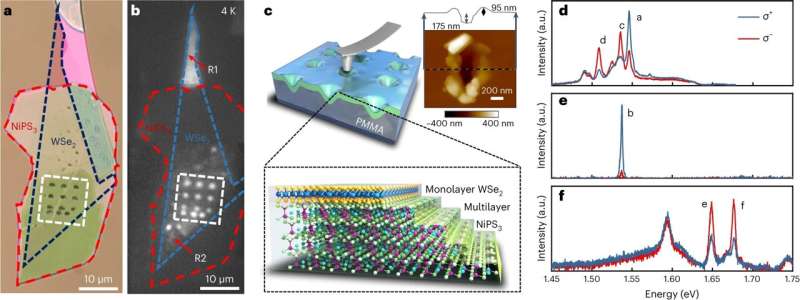This article has been reviewed according to Science X's editorial process and policies. Editors have highlighted the following attributes while ensuring the content's credibility:
fact-checked
peer-reviewed publication
trusted source
proofread
New quantum device generates single photons and encodes information

A new approach to quantum light emitters generates a stream of circularly polarized single photons, or particles of light, that may be useful for a range of quantum information and communication applications. A Los Alamos National Laboratory team stacked two different atomically thin materials to realize this chiral quantum light source.
"Our research shows that it is possible for a monolayer semiconductor to emit circularly polarized light without the help of an external magnetic field," said Han Htoon, scientist at Los Alamos National Laboratory.
"This effect has only been achieved before with high magnetic fields created by bulky superconducting magnets, by coupling quantum emitters to very complex nanoscale photonics structures or by injecting spin-polarized carriers into quantum emitters. Our proximity-effect approach has the advantage of low-cost fabrication and reliability."
The polarization state is a means of encoding the photon, so this achievement is an important step in the direction of quantum cryptography or quantum communication.
"With a source to generate a stream of single photons and also introduce polarization, we have essentially combined two devices in one," Htoon said.
Indentation key to photoluminescence
As described in Nature Materials, the research team worked at the Center for Integrated Nanotechnologies to stack a single-molecule-thick layer of tungsten diselenide semiconductor onto a thicker layer of nickel phosphorus trisulfide magnetic semiconductor. Xiangzhi Li, postdoctoral research associate, used atomic force microscopy to create a series of nanometer-scale indentations on the thin stack of materials.
The indentations are approximately 400 nanometers in diameter, so over 200 of such indents can easily be fit across the width of a human hair.
The indentations created by the atomic microscopy tool proved useful for two effects when a laser was focused on the stack of materials. First, the indentation forms a well, or depression, in the potential energy landscape. Electrons of the tungsten diselenide monolayer fall into the depression. That stimulates the emission of a stream of single photons from the well.
The nanoindentation also disrupts the typical magnetic properties of the underlying nickel phosphorus trisulfide crystal, creating a local magnetic moment pointing up out of the materials. That magnetic moment circularly polarizes the photons being emitted.
To provide experimental confirmation of this mechanism, the team first performed high magnetic field optical spectroscopy experiments in collaboration with National High Magnetic Field Laboratory's Pulsed Field Facility at Los Alamos. The team then measured the minute magnetic field of the local magnetic moments in collaboration with the University of Basel in Switzerland.
The experiments proved that the team had successfully demonstrated a novel approach to control the polarization state of a single photon stream.
Encoding quantum information
The team is currently exploring ways to modulate the degree of circular polarization of the single photons with the application of electrical or microwave stimuli. That capability would offer a way to encode quantum information into the photon stream.
Further coupling of the photon stream into waveguides—microscopic conduits of light—would provide the photonic circuits that allow the propagation of photons in one direction. Such circuits would be the fundamental building blocks of an ultra-secure quantum internet.
More information: Xiangzhi Li et al, Proximity-induced chiral quantum light generation in strain-engineered WSe2/NiPS3 heterostructures, Nature Materials (2023). DOI: 10.1038/s41563-023-01645-7
Journal information: Nature Materials
Provided by Los Alamos National Laboratory





















